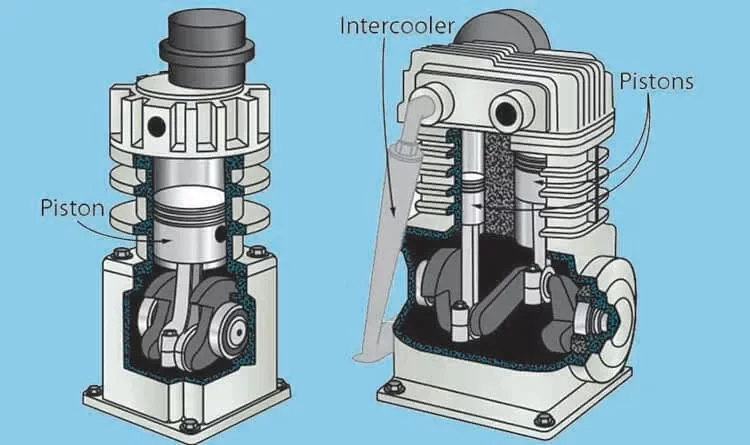by James Williams
Potential buyers of air compressors are often stopped by the pressing question. Do I buy a single-stage air compressor or a two-stage air compressor? How do they differ?
This article is meant to illustrate the differences between the two types of air compressors and see how they compare. So let us examine the two-stage vs. single-stage air compressor debate by starting with what a single-stage air compressor is.
Contents
The basic function of an air compressor is to draw in air and then compress it for storing. Compressing air ends up increasing the pressure of air. This compressed air can then be used to deliver power to certain tools.
A single-stage air compressor has a piston that compresses the air once. The air that is drawn in is compressed to a pressure of 120 psi usually. Two cylinders are used, which both have their inlet valves.
Alternatively, they are known as a dual-stage air compressor. They compress the air twice, unlike a single-stage air compressor. This is done via a second piston.
After the first compression, the air is not taken to the storage tank but a second smaller piston, which compresses the air to a pressure of about 175 psi. It is then finally stored.
So a two-stage air compressor stores air at a higher pressure. This means it can power stronger tools and be used in large scale tasks that single-stage air compressors can't.

Since you have the basic rundown of the two types of air compressors, let's compare them and see how they differ in certain aspects.
Two-stage or dual-stage air compressors compress the air to a higher pressure, so they produce higher power. They are meant to work with more powerful pneumatic tools that operate at pressures of 200 psi. Single-stage compressors produce lower power.
Due to the inclusion of a second cylinder and cooling tube in a two-stage compressor ends up being heavier than most single-stage air compressors. This makes it harder to carry around. Single-stage air compressors being on the lighter side, have the added benefit of being more portable and a good option to have.
Single-stage air compressors make use of one piston and compress the air to lower pressure. This requires less input energy to run. Dual-stage air compressors need more energy to run both pistons. So you'll need a stronger power source for it.
You'll often find single-stage air compressors used in auto shops or personal workspaces due to their smaller size and smaller power output. Single-stage air compressors can power most saws and nailers for smaller-scale use in woodworking.
Two-stage air compressors are used in factories. They pump out more power and so they can be used with more powerful tools and can also power multiple tools at the same time, which is needed in a factory.
While the initial buying cost of two-stage air compressors is much higher but they have fewer maintenance costs. When used in a factory setting, the overall costs tend to even out. Single-stage air compressors are much cheaper to buy.
If you want to stock up on an air compressor for factory or heavy-duty work, two-stage air compressors will prove cheaper and more useful. If you need something you can use to work at home, you'll want a single-stage air compressor since it's cheaper and quieter.
Nevertheless, let us know if you liked the two-stage vs. single-stage air compressor comparison guide.
About James Williams
Hi, This is James from HomerDIY. I have great experience in writing about everything related to Pump and DIY tools. For the last few years, I am researching the different types of tools and sharing my opinion on this blog.
 |
 |
 |
 |
Popular Posts